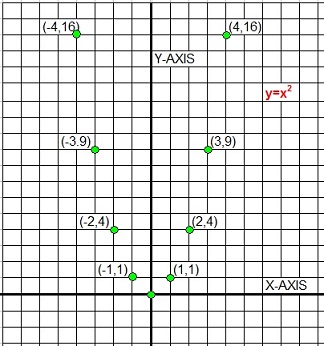| value of x: | value of y: |
| x= -4, then | y= 16 (because -4 x -4 = 16) |
| x= -3, then | y= 9 (because -3 x -3 = 9) |
| x= -2, then | y= 4 (because -2 x -2 = 4) |
| x= -1, then | y= 1 (because -1 x -1 = 1) |
| x= 0, then | y= 0 (because 0 x 0 = 0) |
| x= 1, then | y= 1 (because 1 x 1 = 1 |
| x= 2, then | y= 4 (because 2 x 2 = 4 |
| x= 3, then | y= 9 (because 3 x 3 = 9 |
| x= 4, then | y= 16 (because 4 x 4 = 16) |



| x1= | -b + √(b2 -4ac) ------------------- 2a |
| x2= | -b - √(b2 -4ac) ------------------- 2a |

